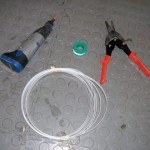



This is a really quick tutorial of how to sew on buttons in a way that’s both strong and neat. I’m experimenting with webcam tutorials, so if you want more videos please let me know. Only issue is that it has to be short and my camera isn’t very high quality. Any ideas please let me know and I’ll try to record myself doing it!
I’m back from Eastercon and Bristol Alternative Market, and the site has finally moved over to its new server! As celebration, it’s time for another tutorial!
This is the basic technique for making convention safe foam weaponry. It’s based on techniques used by LARPers, so these swords are light, durable and won’t hurt people if you bash them. The exact same technique was used on Seigfried’s sword, just scaled up with a much thicker core and foam.
I’ve never found another tutorial for this on the internet, so here’s hoping it’s helpful! Let’s begin. (more…)

Now this is something I get asked about a lot- how do you bone your corsets? I use flat steel boning, which you can buy from Vena Cava. I use the 13mm stuff because it’s a easy measurement to make 15mm boning cases on my machine, and it’s heavy duty without being too hard to work with.
So first off, why steel boning? Well, most people don’t realise that with corsets it’s actually the fabric that does all the cinching in. The boning is there to push the fabric out so it doesn’t rumple and hurt you. The more boning and the stronger the boning the more comfortable a corset actually is. Steel boning is actually easier to use than you think, and works out just as cheap as many other alternative methods out there.
The issue with steel boning is that you have to finish the tips, otherwise it will just poke its way out of the corset over time. This tutorial will show you the method I use to make my tips safe, so without further ado, here are the materials you need!
You will need:
You will also need the corset you’ll be boning so you can take the measurements.
Whew- this tutorial is a mouth full!
I’m covering two hated things here- bias binding and it’s fancy little square corners. This is how to make something like this:
See it’s beautiful corners and the way it’s great on either side? Yeah, if you want to know how to do it, walk this way….
This tutorial is about how to make a lot of bias binding if you need it.
Bias binding is useful for many things, mainly edging. You can make it out of practically any woven fabric as long as it’s not too thick. I make most of my own bias binding because I like to colour match, and also because the satin used for the regular reels of the stuff tend to be really shiny and horrible.
What is bias binding? Bias is the diagonal on a woven piece of fabric. But cutting on the bias you can take a non stretch fabric and make it stretchy enough to be sewn around corners.
You will need:
I’ve made a tutorial! The first one is a nice easy one that I thought people would find interesting. It’s how to make a very large hair bow that stands up. I know my costumes don’t look like I make this sort of thing a lot, but it’s something I do often as part of commission work.
Let me know what you think of the gallery system! This is my first time testing this, I’d like to know what you think.
Here are some tutorial ideas that I’ll be doing next: